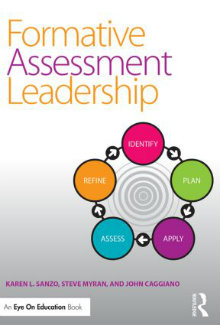A Strategy to Structure Formative Assessment
Formative Assessment Leadership: Identify, Plan, Apply, Assess, Refine
By Karen L. Sanzo, Steve Myran, and John Caggiano
(Routledge/Eye on Education, 2015 – Learn more)

As a district administrator I wanted to read this book to discover ways that I could help the teachers in my department expand their formative assessment practices. As I began reading, I realized that this book provides a road map to administrators to foster school improvement.
Sanzo, et al. take the ideas behind classroom formative evaluation – providing students with assessment and feedback – and expand on them so that they can be used for data-based decision making.
Sanzo, et al. describe four simple factors that improve learning (pg. 18):
- Forward feedback
- Active involvement of students in their own learning
- Adjusting teaching to take account of the results of formative assessment
- A recognition of the profound influence assessment has on engagement and self-efficacy

The authors emphasize throughout the book that the most productive kind of formative assessment is self-assessment, whether it is by students assessing progress towards learning goals or teachers assessing the efficacy of instructional practices. This assessment requires active involvement of the stakeholders, and the hope is that this type of assessment will foster independence.
A five-step improvement process
Sanzo, et al. identify a five-step cycle for instructional improvement. For each step of the cycle, they provide the reader with worksheets that help facilitate the implementation of the ideas being discussed.
- Identify – In this step educators use a schoolwide review of data to identify specific areas of targeted improvement. Sanzo, et al. provide two observation tools that can be used to collect information on the instructional and assessment practices that are being used in classrooms.
- Plan – Sanzo, et al. state that while there needs to be alignment from classroom to classroom about the types of instructional changes that are being made, differences from classroom to classroom need to be respected. Teachers need opportunities to discuss these changes and how well they are working throughout the process. Teachers also need to discuss with students what quality work looks like as it relates to accomplishing the established learning goals.
- Apply – The cornerstone of this step is communication. Administrators need to be actively observing and providing feedback. Teachers need to be working collegially to provide feedback to each other, administrators, and students. Students need to be active participants by developing learning goals and assessing their progress towards those goals.
- Assess – Sanzo, et. al provide the readers with common formative assessment strategies and how they can be used in the classroom. The authors emphasize that the teachers should create the strategies and analyze the results collaboratively.
- Refine – The authors recommend that teachers determine what was learned from this process of formative assessment and focus on the most effective strategies going forward. They also recommend that when reviewing strategies teachers should determine if the strategy just doesn’t work or if there was a common implementation challenge that can be overcome.
As this is a cycle, “Refine” is not necessarily the last step. Sanzo et. al suggest that the cycle can be repeated beginning with whatever step is appropriate based on the circumstances.
As summer is a time for reflection as an educator, I am excited to have read this book. I think the authors provide the readers with concrete, actionable strategies that can improve student learning. By reading this book, I was able to accomplish my original goal: to find strategies to help the teachers in my department improve their formative assessment practices.
I was also able to come away with a whole lot more. I plan on using the five-step cycle for instructional improvement going forward to help me identify and use the data and practices that will help improve student understanding.
Brian Taylor is the Director of Science and Engineering Technology K-12 for the West Islip Union Free School District on Long Island, New York. Brian has also been a Dean of Students and Chemistry teacher.


































